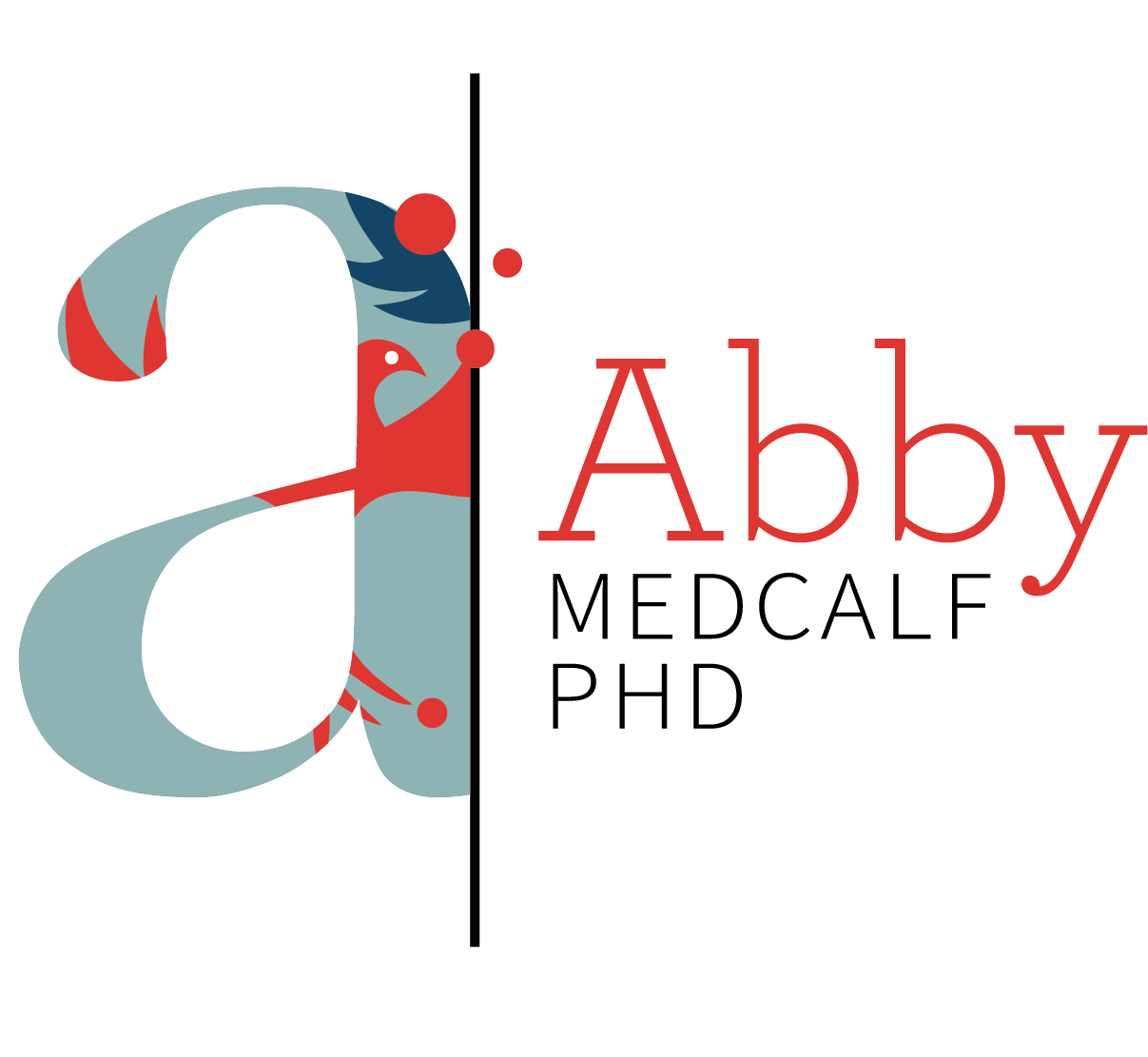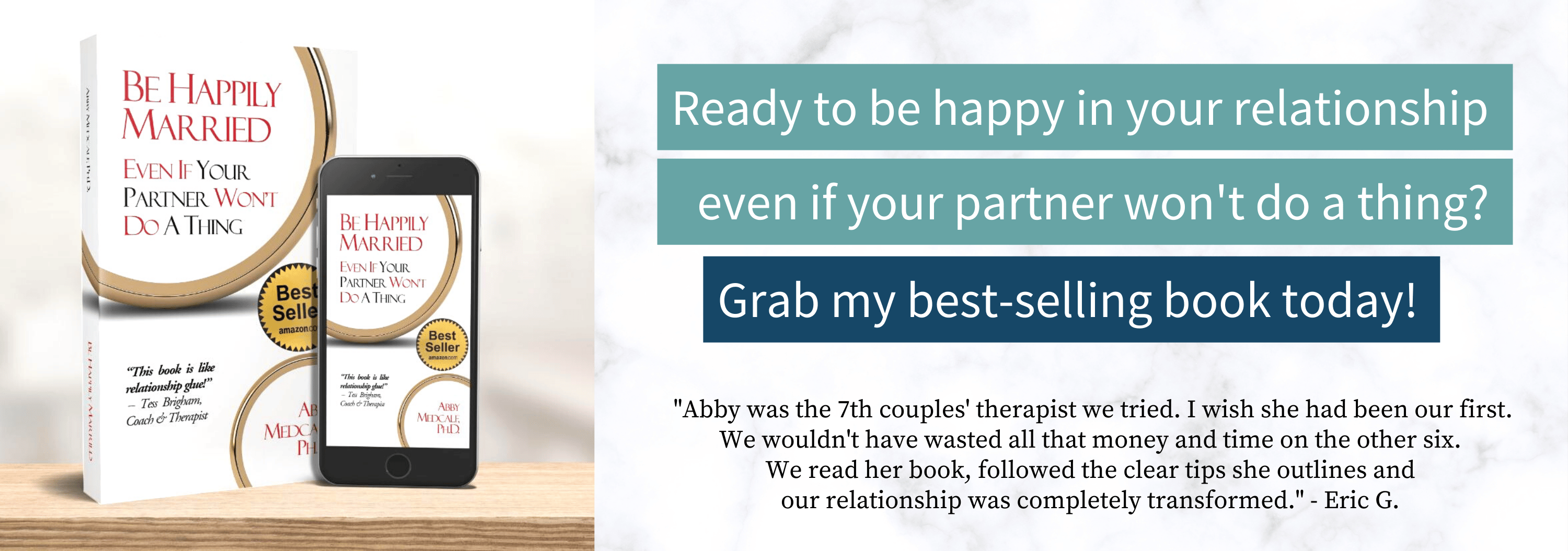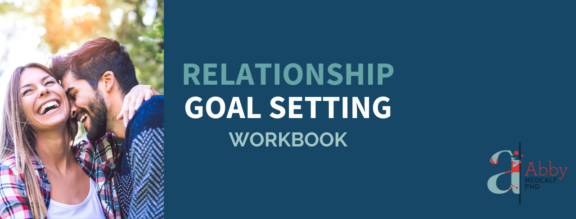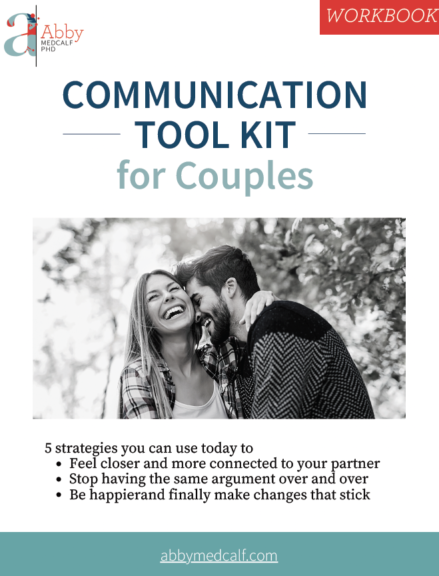
You’ve always got two choices to make in your relationship: evolve and grow or repeat and stay stuck in old patterns. Don’t wait until after the holidays, the first of next month, or the first of next year to set goals. If your relationship doesn’t feel the way you want, there’s no better time to set and achieve new relationship goals, than right now. Today we’re going deep on the five goals every couple should set in their relationship. One day or day one. You decide.
14-minute read
Goal #1: It’s a We Thing
Approach any issue as a “we” thing, not a “you” or “them” thing. If your partner comes to you complaining that you never want to have sex anymore, often the initial reaction is to refute it and start listing all the times you’ve had sex recently or the special circumstances about why you didn’t want to have sex on Saturday. You’re trying to prove them wrong, so this sets you up on opposite sides (with them being wrong and you being right).
Instead, approach problems like this from a “we” perspective. If your partner thinks you never want to have sex anymore, there’s something going on that you want to understand. What does sex mean to them? What would “enough” sex look and feel like? Is there anything else they need from you that they’re not getting? Is this about sex or something else? Do they feel loved and wanted? The goal is to join them in this issue. It doesn’t mean either of you is wrong; it means that your partner is experiencing something, and you want to be on their team to figure out a solution.
No matter the issue, don’t get on opposite sides, argue, or refute what your partner is saying. Instead, seek to listen well, understand, and work on the problem together.
You want to fight the problem, not one another.
Goal #2: Share True Feelings Like Confetti
A great goal to set with your partner is to share true feelings as often as possible. This is harder than it sounds because there are two mistakes most people make when it comes to sharing feelings:
The first mistake is sharing reactions, not their true feelings. Our true feelings are usually beneath our initial reactions. For example, your partner might say something that upsets you, and you lash out in anger. Yes, anger is a feeling, but what’s underneath that? Anger, resentment, frustration, and impatience are “top” feelings and often reactionary ones. You want to give yourself a moment and dig down to what’s under those feelings to get to the real ones. What’s really upsetting you? Are you feeling abandoned or rejected by them? Does it seem like they don’t have your back or you’re feeling sad and alone and not like a team?
When you’re first practicing this, a great strategy is not to share feelings right away and to, instead, take a moment to calm yourself and see what’s really going on. It’s easy to be angry or resentful. What’s harder is to get to your real fears.
When you’ve gotten to the real issue, you’ll come back to your partner with a completely different conversation. Instead of arguing the points of what happened: “You said X, and it made me mad,” and them replying, “You misunderstood me. I said Y, and you’re overacting.” You can see where this goes: nowhere. You end up stuck in a loop where nothing is resolved.
When you check in with yourself and realize you felt abandoned when your partner didn’t remember your big presentation at work, you might even realize that you don’t need to have any conversation with them because this is about you, not them. However, you might still want to say something to gain their support and this conversation will go very differently from the reactive one where you’re yelling at them that they don’t care about you and they walk away bewildered and upset. Being honest on this level with your true feelings deepens your connection and trust with your partner.
The second mistake is sharing thoughts when you think you’re sharing feelings. Often people share their judgments and thoughts about what’s happening and don’t even realize they’re not sharing an actual feeling! I’ve said this 100 times, and I’ll keep saying it: we don’t connect with thoughts; we connect with feelings! It’s when we’re sharing our feelings and being vulnerable that we strengthen and deepen our connections. So, take a moment (or two or three) and identify what you’re truly feeling about whatever it is that you want to share.
Not sharing feelings creates a lot of distrust in relationships. For example, you think you can tell that your partner is upset about something (and that’s up for debate, just for the record), but when you ask, they say that everything is fine. You believe they’re not sharing something, so you start to distrust them because not sharing or omitting is the same as lying in a relationship. Fast forward to later in the week, and your partner is saying how sexy you look, but you don’t believe them! I mean, they weren’t honest last week; what’s to say they’re being honest now? You think, “They’re just saying that to make me feel better or because they want sex!” You end up dismissing, discounting, and second-guessing everything they say!
Before I jump into Goal #3, I want to mention that I’ve got a Relationship Goal Setting Workbook that you can buy on the website on the Shop Page (when you’re buying inspirational mugs, t-shirts, and notebooks for all your friends). The workbook covers very different ground than we’re talking about today; it’s very nitty gritty on exactly how to set goals if that’s something you want to do.
In This Workbook, You’ll Learn:
- The six steps to set relationship goals that work.
- An easy, guided plan to put your relationship goals into action.
- The mistakes that most couples make when setting relationship goals and why you’ve been stuck in the past.
- How to track your goals for continued success.
Goal #3: Say “Yet” Often
I’ve been studying the work of famed Stanford researcher and author Carol Dweck for decades now. She’s most famous for her book, Mindset and the idea of having a growth or fixed mindset. A growth mindset is just that. Nothing is fixed in this moment, and anything is possible (these are the most successful and creative people). Having a growth mindset in your relationship is huge, and a simple tool to help that happen is to use the word, yet. When you say yet, you’re saying there are things worth waiting for, and those things take work.
Think of these statements and how they make you feel:
- I’m not good at this… yet
- I don’t understand this… yet
- I can’t do this… yet
- This doesn’t work… yet
Yet is a magical word. It speaks to possibilities and great things in the future. It speaks to tackling problems, removing obstacles, and having a happy life. Use the word yet as often as possible when you’re having difficulties with your person (or with yourself).
- “We haven’t figured this out yet.”
- “We don’t have a solution yet.”
- “I don’t understand what you’re saying yet.”
You can also use yet as a more positive answer. If your partner laments that they can’t communicate with you, you could answer, “We’re not communicating well yet.” Instead of framing anything unwanted in your relationship as bad or a mistake, yet gives you the opportunity to improve. It says you’re not done, and it gives you the confidence to continue to learn and grow.
When you use the word yet, you’re saying that you’ll figure it out, have a solution and find common ground. You’re saying you’re on your way and need to strategize some more. Yet is holding optimism for your relationship even when that’s hard in a moment. Yet gives you a path to the future relationship you want.
Goal #4: Focus on What You Do Want, Not What You Don’t
One of the biggest mistakes you’re making is that you’re focusing on what you don’t want in your relationship but then expecting what you do want to show up! This never works! You’re thinking of what you’re missing and then wanting that missing thing to show up, but it doesn’t because your energy is focused on what’s missing, what’s not there, not what you actually want. So that’s what keeps showing up!
This is often called the Law of Attraction (and I did a whole episode way back in season 2 of the podcast – episode 58), but I’m going to give you a quick lesson today so you can understand that this isn’t bullshit woowoo stuff. It’s real science! I’m going to take a quick detour down the quantum science road, but you’ve got to know about quantum to understand that the law of attraction is a real thing.
So, you’re basically a walking, talking ball of energy with a little matter thrown in. Energy is different than matter. Matter is all the stuff you can touch or that has “weight.” Water, tables, chairs, trees, your body, your cell phone, and pretty much everything that you see around you is all matter.
All of this matter is made up of molecules, and molecules are made up of something even smaller called atoms. Atoms are basically the building blocks of all matter or things. About 99% of your body is made up of atoms of hydrogen, carbon, nitrogen, and oxygen.
Now, these atoms are made up of even tinier pieces of matter called subatomic particles. There are 118 different types of atoms which we call elements and these all make up that periodic table you may remember from high school. All of these elements or atoms are the basic building blocks of everything and can’t be divided up anymore. (Scientists had proven that atoms existed many years ago with mathematics, but we’d never “seen” one until very recently, in 2017!
Now, here’s the kicker: Atoms themselves are mostly made of empty space! If an atom was the size of a church, the nucleus, or center of that atom, would be the size of a dime! All the rest is space. These things that make up everything you see around you are mostly empty space! What?!?!
But Abby, if atoms are mostly empty space, and everything is made up of atoms, why do objects look and feel solid? Why do humans look and feel solid? We don’t experience ourselves or anything around us as being empty space because everything in and around us is moving so fast that it seems solid.
The best way I’ve heard this explained is to think about the empty space in an atom like you’d think about an electric fan with rotating blades. When the fan isn’t in motion, you can see that there’s a lot of empty space in the fan around the blades. You can stick your hand into the space between the blades and wiggle your fingers around in all the nothingness.
But when that fan is turned on, the game is changed. If you put your hand into all that “empty space,” now you’d get hit by the blades and feel the resistance of something “real.” If you spin something fast enough, it looks solid.
This is why quantum physicists speak like the world is on an LSD trip. One of the most famous physicists of our time, Niels Bohr, said: “If quantum mechanics hasn’t profoundly shocked you, you haven’t understood it yet. Everything we call real is made of things that cannot be regarded as real.”
Let’s get back to our matter/energy talk. We talked about things that are matter: that cell phone you’re likely holding right now, your car, or your house. Now let’s talk about things that are not matter. Things that are not matter include feelings, thoughts, and light. Light, of course, lets you see all the matter around you, but it’s different from matter. The main difference? Light doesn’t weigh anything. Even air has a weight, but light, feelings and thoughts don’t.
But just because it doesn’t weigh anything, and you can’t “see it” doesn’t mean you don’t feel it. You believe that light, thoughts, and your feelings are real even though you can’t feel or see all of them, so now I need you to extend that to the energy and vibrational frequency you’re putting out all the time. Since you’re mostly made up of atoms and all of these atoms and subatomic particles are in constant motion, they all put out their own distinct frequency or vibration, from low to high, and we know from science that like frequencies attract other like frequencies.
So, low vibrational thoughts attract low vibrational experiences or things.
For example, if you want to have a great relationship but you’re super stressed about said relationship, you’re not going to attract what you want. If you’re saying, thinking, or believing things like, “We’ve tried things before, but changes never stick,” you’ll attract negative experiences in your relationship. All those thoughts you’re having, and subconscious beliefs are putting out a vibration. Your words might be different, but it’s the vibration that’s doing all the work.
Think right now about what your dominant vibration is (it’s going to align with the dominant and most frequent thoughts you’re having). Now think: “What’s the vibration of my dream life and relationship?” Do they match? Where are the gaps?
You have to change your energetic vibration in order to change your relationships (and life), and it all begins with your thoughts. They say you can’t grow an apple tree with cucumber seeds! If your words are all about apples, but those thoughts and vibrations are all about cucumbers, guess what you’re going to get?
Everything in your life, right this minute, is a reflection of your vibratory state. It’s a reflection of the frequency you’re operating on. This is actually good news because it means it’s in your power to shift and create new things in your life. First, though, you have to know where you’re starting from, and looking at your current relationship gives you that starting point. If you want to change how fast your car is going, you can’t do that until you know what your speed is right now. Your current, consistent emotional state is your speedometer. Remember, you feel the way you think, so these emotions are letting you know what you’re truly thinking.
Let’s talk more about these low and high vibrational states.
Low vibrational emotions and states are anxiety, jealousy, hate, hopelessness, helplessness, overwhelm, frustration, resentment, and depression. When you’re moving up the scale, you get to something like anger. Anger is actually a higher vibrational state than depression, so it’s actually better to be angry than to be depressed.
Of course, you’re really looking to experience even higher vibrational states the most often. These include gratitude, appreciation, compassion, kindness, gentleness, laughter, ease, confidence, inspiration, calm, happiness, joy, thoughtfulness, openness, and willingness.
If you want to get from a low to a high vibrational state, it’s all about your attention. You change your frequency by where you put your attention. If you focus on all the things you don’t like about your partner or your relationship, you’ll start to feel like poop. And that emotion is the indicator of your frequency.
You get what you focus on. If you’re vibrating a frequency of need and want, neediness and wanting will attract more need and want. Instead, you need to become what you want so the neediness and want disappear. Your relationships (and life) are the reflection of your vibratory state. If you don’t have the relationship you want, it’s time to focus on your thoughts and create the vibrational frequency you want to attract.
Whenever you feel a negative emotion, you’re calibrating to something you don’t want. So, think of its opposite, or what you do want, and calibrate to that. You can’t feel disappointed and get what you want.
I don’t want you to be afraid of any negative thinking during your day. Instead, I want you to reframe it as a signal to calibrate. Because when you’re seeing or feeling what you don’t want, it’s a signal that you need to think about what you do want. Think of it as a reminder for now, not a fact. Remember that the grass is greener where you water it.
Goal #5: Be Kind, No Matter What
The last goal is key: set an intention of kindness with your partner on a daily basis. How your relationship feels day-to-day boils down to what energy, attitude, and thoughts you’re bringing to the relationship. Are you focusing on being kind, generous, open, loving, and patient? Or are you generally bringing criticism, hostility, contempt, or negativity?
Research has shown that kindness (along with emotional stability) is the most important predictor of satisfaction and stability in a marriage. Kindness makes each partner feel cared for, understood, and validated. Kindness makes people feel loved.
Researchers have found that couples who look for things to appreciate are happier and stay married longer than those who’re always looking for their partner’s mistakes. The best way to be appreciative and focus on the positive is to keep it simple and just focus on being kind. Kindness should be bottled as “Couples Glue.” It creates affection, bonding, validation, and more kindness as your partner reacts in kind (pun intended). Weave kindness into the fabric of your interactions with your partner on an all-day basis.
If you want the nitty gritty on how to set relationship goals, get the Relationship Goal Setting Workbook. These are the proven steps to create connection and happiness in your relationship for the long-term.
In This Workbook, You’ll Learn:
- The 6 steps to set relationship goals that work.
- An easy, guided plan to put your relationship goals into action.
- The mistakes that most couples make when setting relationship goals and why you’ve been stuck in the past.
- How to track your goals for continued success.
Resources for Goals Every Couple Should Set
Get my #1 bestselling book on Amazon, Be Happily Married: Even If Your Partner Won’t Do a Thing
How the Law of Attraction Works in Your Relationship
The Secret to Positive Thinking in all Your Relationships
The Secret to Managing Your Emotions: A Step-by-Step Guide
Calibration Exercise: Create a Positive Vibration to Start Your Day








